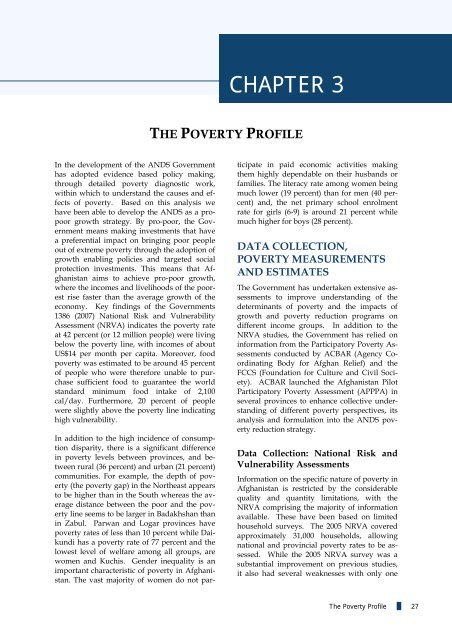Islamic Republic of Afghanistan - Enhanced Integrated Framework ...
Islamic Republic of Afghanistan - Enhanced Integrated Framework ...
Islamic Republic of Afghanistan - Enhanced Integrated Framework ...
Create successful ePaper yourself
Turn your PDF publications into a flip-book with our unique Google optimized e-Paper software.
CHAPTER 3THE POVERTY PROFILEIn the development <strong>of</strong> the ANDS Governmenthas adopted evidence based policy making,through detailed poverty diagnostic work,within which to understand the causes and effects<strong>of</strong> poverty. Based on this analysis wehave been able to develop the ANDS as a propoorgrowth strategy. By pro-poor, the Governmentmeans making investments that havea preferential impact on bringing poor peopleout <strong>of</strong> extreme poverty through the adoption <strong>of</strong>growth enabling policies and targeted socialprotection investments. This means that <strong>Afghanistan</strong>aims to achieve pro-poor growth,where the incomes and livelihoods <strong>of</strong> the poorestrise faster than the average growth <strong>of</strong> theeconomy. Key findings <strong>of</strong> the Governments1386 (2007) National Risk and VulnerabilityAssessment (NRVA) indicates the poverty rateat 42 percent (or 12 million people) were livingbelow the poverty line, with incomes <strong>of</strong> aboutUS$14 per month per capita. Moreover, foodpoverty was estimated to be around 45 percent<strong>of</strong> people who were therefore unable to purchasesufficient food to guarantee the worldstandard minimum food intake <strong>of</strong> 2,100cal/day. Furthermore, 20 percent <strong>of</strong> peoplewere slightly above the poverty line indicatinghigh vulnerability.In addition to the high incidence <strong>of</strong> consumptiondisparity, there is a significant differencein poverty levels between provinces, and betweenrural (36 percent) and urban (21 percent)communities. For example, the depth <strong>of</strong> poverty(the poverty gap) in the Northeast appearsto be higher than in the South whereas the averagedistance between the poor and the povertyline seems to be larger in Badakhshan thanin Zabul. Parwan and Logar provinces havepoverty rates <strong>of</strong> less than 10 percent while Daikundihas a poverty rate <strong>of</strong> 77 percent and thelowest level <strong>of</strong> welfare among all groups, arewomen and Kuchis. Gender inequality is animportant characteristic <strong>of</strong> poverty in <strong>Afghanistan</strong>.The vast majority <strong>of</strong> women do not participatein paid economic activities makingthem highly dependable on their husbands orfamilies. The literacy rate among women beingmuch lower (19 percent) than for men (40 percent)and, the net primary school enrolmentrate for girls (6-9) is around 21 percent whilemuch higher for boys (28 percent).DATA COLLECTION,POVERTY MEASUREMENTSAND ESTIMATESThe Government has undertaken extensive assessmentsto improve understanding <strong>of</strong> thedeterminants <strong>of</strong> poverty and the impacts <strong>of</strong>growth and poverty reduction programs ondifferent income groups. In addition to theNRVA studies, the Government has relied oninformation from the Participatory Poverty Assessmentsconducted by ACBAR (Agency CoordinatingBody for Afghan Relief) and theFCCS (Foundation for Culture and Civil Society).ACBAR launched the <strong>Afghanistan</strong> PilotParticipatory Poverty Assessment (APPPA) inseveral provinces to enhance collective understanding<strong>of</strong> different poverty perspectives, itsanalysis and formulation into the ANDS povertyreduction strategy.Data Collection: National Risk andVulnerability AssessmentsInformation on the specific nature <strong>of</strong> poverty in<strong>Afghanistan</strong> is restricted by the considerablequality and quantity limitations, with theNRVA comprising the majority <strong>of</strong> informationavailable. These have been based on limitedhousehold surveys. The 2005 NRVA coveredapproximately 31,000 households, allowingnational and provincial poverty rates to be assessed.While the 2005 NRVA survey was asubstantial improvement on previous studies,it also had several weaknesses with only oneThe Poverty Pr<strong>of</strong>ile 27
















